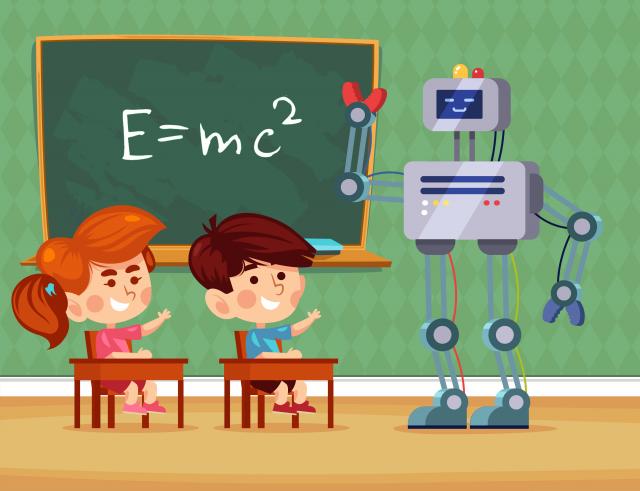人工智能對學與教帶來的衝擊
人工智能正以超越我們能夠想像的方式去改變世界。從Siri和Google Assistant 等安裝在我們手機上的語音助手,到能夠在圍棋對弈中戰勝人類的AlphaGo,人工智能已經以不同形態成為我們日常生活的一部分。與擴增實境及虛擬實境相比,目前人工智能輔助教學的技術還處於起步階段。但在不久將來,更多更具創意的人工智能應用將會為教學帶來全新面貌。
就讓我們了解一下現今人工智能在教學的應用:
1. 智能輔助教學系統
現時已有不少輔助教學系統加入了人工智能技術,並應用於輔助學生學習基礎數學及英文寫作。市場上正在研發這類系統的公司有Thinkster Math及Front Row等,教師可以利用系統跟進學生的表現及了解他們學習上遇到的困難,同時亦可以分析學生用哪種學習方法效益最大。採用智能輔助教學系統後,教師將可以騰出更多寶貴時間用作教導學生高層次的技能,例如批判性思考能力,解難能力和創造力等。

圖像由 Freepik 設計
美國佐治亞理工學院研發了一位名叫Jill Watson的智能助教。她能夠在網上討論區解答學生問題,因為她是一部由IBM Watson AI平台支援的電腦。在系統開始運作前,科研人員預先在IBM Watson AI 平台輸入了超過40,000個論壇貼文。學生在討論區發問後,Jill Watson便可在數據庫中搜尋類似的問題並作出即時回應。很多學生即使對課堂內容存有疑問,亦不喜歡在課堂上公開提出。但隨著智能助教的出現,學生可以選擇在網上作個別提問,而且智能助教的耐性絕對無人能及,讓學生可以不斷重複發問。
2. 自動化寫作評分工具
教師對學生寫作給予的回饋能有效促進學習,及對學生發揮正面的激勵作用。但如果學生人數眾多,例如是大規模開放在線課程,教師要給予所有學生回饋就可能是一項艱鉅的工作。由於大規模開放在線課程會在Coursera等國際性平台作全球招生,一些受歡迎的課程可能會有來自全球超過100個國家的學生報讀,所以教師往往難以為每一位學生作出回饋。對於這個問題,人工智能技術可能是唯一的解決辦法。
WriQ是一個智能的寫作評估工具,作用是建立英語寫作的一套評分標準。大量已被評分的文章會預先輸入用作校準系統,之後系統會建立一個龐大的數據庫及為WriQ訂立評分標準,評分標準包括字詞拼寫、標點符號運用和文法等各方面的準確性。當系統評估學生的文章後,系統會自動把回饋直接嵌入文章內。現時系統在評估學生的表達能力及想像力方面仍然有相當限制,但系統將會不斷改良,令評分標準更人性化。
3. 對話式收集課程意見
在課程結束後,使用問卷調查去評估教學成效是十分普遍的做法,這個做法既有效,亦簡單快捷。除了由傳統紙張問卷演變成網上問卷之外,似乎沒有其他更創新的方法收集意見。
以現時一日千里的技術,評估課程的方法應該存在很大的改善空間。以智能聊天機械人Hubert為例,透過學生與聊天機械人的對話,系統會收集學生給予教師的評語。學生以對話形式表達意見比填寫問卷更自然,亦更願意表達真實的意見。在收集意見時,聊天機械人可以根據學生的回應,即時改變後續問題,具有與真實對話相似的優點,但所需的時間卻大大減少。

Designed by Freepik
4. 預測學生成績表現
教育資料探勘是一種新興的技術,適用於發掘教育界中獨特的資料,而資料可以由電子學習平台及院校的行政數據庫中取得。教育資料探勘可以解答一些抽象問題,例如「找出有可能在考試合格的學生」這些不可能在傳統數據庫中得到答案的問題。教育資料探勘可透過建立數據模型來預測學生的未來學習行為,當中包含學生的知識、動機、認知和態度等詳細資料。因此,研發人員已經著手研究各種資料探勘方法去協助教育工作者加深對學生的了解。
市場上其中一個預測分析系統Blackboard Predict使用了的學生資料和電子學習平台的數據來建構預測模型。系統能為教育工作者提供適時的信息,令他們以最快時間識別和接觸到成績有機會低於平均水平的學生。另外,在大規模開放在線課程方面,edX和Coursera平台已經引入這種技術來改進他們的課程。他們使用人工智能技術來監測學生的進度,並在學生表現可能出現問題時提醒教師,令學生可以盡快獲得協助,而教師亦得知課程還有甚麼改善空間。
雖然人工智能在教育領域發展迅速,並且在學習分析和智能輔助教學方面發揮重大作用,但教師的角色絕對不會被取代,因為只有教師才能夠把互動學習體驗帶入課室。在未來,隨著人工智能技術的不斷改進,電腦將會有更強的溝通能力,智能導師亦具有更接近人類的思考模式。或許有一天當我們都能乘坐無人駕駛汽車外出的時候,人工智能已經在教育領域帶來翻天覆地的改變。
延伸閱讀:
Blackboard. (2017). Blackboard predict. Retrieved November 23, 2017, from http://www.blackboard.com/education-analytics/blackboard-predict.aspx
EdTechReview. (2013, June 22). What is educational data mining (EDM)? Retrieved November 23, 2017, from http://edtechreview.in/dictionary/394-what-is- educational-data-mining
Hubert. (2017). Retrieved November 23, 2017, from https://www.hubert.ai
Livieris, I.E., Drakopoulou, K., & Pintelas, P. (2012). Predicting students' performance using artificial neural networks. Retrieved November 23, 2017, from http://www.math.upatras.gr/~kdrak/Papers/LDP12.pdf
OnlineUniversities. (2012, Oct 30). 10 ways artificial intelligence can reinvent education. Retrieved November 23, 2017, from http://www.onlineuniversities.com/blog/2012/10/10-ways-artificial-intelligence-can-reinvent-education
How Artificial Intelligence (AI) Impacts Learning and Teaching
Artificial Intelligence (AI) is changing the world in more ways than we can imagine. From digital assistants like Siri and Google Assistant in our mobile phone, to AlphaGo that plays the board game Go with human, AI in its many forms is now part of our everyday life. AI is still in its early days as an educational tool compared with other technologies such as augmented reality (AR) and virtual reality (VR), yet there will be more innovative applications to enhance learning and teaching by using AI technology in the near future.
Let's take a glance at the AI applications in the education sector nowadays:
1. Intelligent Tutoring System
Some tutoring systems based on AI technology have already existed to help students with basic Mathematics and English writing. Software companies, such as Thinkster Math and Front Row, are developing intelligent tutoring system to track students' performance, identifying the concepts that the students find difficult as well as suggesting the learning methods work best for them. Saving time on the above-mentioned work which can be conducted by AI technology, teachers can have more time to work with students on some high-level skills like critical thinking, problem solving and creativity.

Designed by Freepik
An example of intelligent teaching assistant is Jill Watson developed by the Georgia Institute of Technology in the USA. Jill Watson can respond to students' enquiries in online discussion forums because she is a computer powered by the IBM Watson AI platform. The research staff in the Department of Computer Science fed IBM Watson AI platform with more than 40,000 forum posts to get the system up and running. Students ask questions in the forum and Jill Watson searches similar questions in the database to provide instant support. It is very common that some students are uncomfortable asking in class, even though they have questions. However, with an intelligent teaching assistant, students can make online enquiries privately. The intelligent teaching assistant is also infinitely patient and allows students to ask questions over and over.
2. Automated Essay Scoring System
Giving feedback to students' written essays is motivating and encouraging to students in the learning process. However, it could be a challenging task for teachers to give feedback to a large number of students, such as in Massive Open Online Courses (MOOCs). MOOCs are open to global enrolment on international platforms like Coursera. For some popular courses, there can be students from over a hundred countries around the world, so it is unlikely for teachers to give feedback to every student. To solve this problem, AI technology may be the only solution.
WriQ is an intelligent writing assessment tool for creating a standard measurement for English writing. A large set of pre-scored essays are used to calibrate a scoring system. Once calibrated, the system will be able to create an enormous data set to robustly establish the WriQ score as a standardised norm for assessing writing. It can give a quantitative assessment on spelling accuracy, punctuation correctness and grammar correctness. Once scores are calculated automatically, students receive immediate feedback directly embedded to their writing. There are limitations on evaluating expressions and creativity of writing at this moment, but continuous improvement is trying to make humanised scoring achievable.
3. Conversational Course Evaluation
Questionnaire is a common method to evaluate teaching effectiveness at the end of a course. It is popular because evaluation with questionnaire is simple and effective. Apart from moving from paper to online surveys, there has been minimal progress to make the feedback process better in any way. It is obvious that there is still a lot of room for improvement with modern-day technology.
With AI-driven chatbots, such as Hubert, students are engaged in a chat-session where valuable feedback to teachers is obtained. Engaging students in conversation rather than asking them to fill out a questionnaire is more natural and the collected data are more realistic. Follow-up questions can also be tailored according to the responses of the students. A chatbot can collect opinions through a conversational interface with the same advantages as a real interview but with a fraction of the required time.

Designed by Freepik
4. Predict Student's Performance
Educational Data Mining (EDM) is an emerging technology for exploring the unique types of data that come from educational context. The educational data are taken from students' use of learning management systems and administrative data from the school. EDM can provide answers to some abstract questions like “find the students who will possibly pass the examinations”, which is not possible to execute in traditional database queries. EDM can be used for predicting students' future learning behaviour by creating student models that incorporate detailed information, such as students' knowledge, motivation, metacognition and attitudes. Hence, researchers have begun to investigate various data mining methods to help educators better understand their students.
‘Blackboard Predict' is an example of predictive analytics solution in the market. It uses data from the existing students' information and learning management systems to build a predictive model. The predictive analytics solution provides educators with timely information so that they can identify and reach out to underperforming students before it is too late. In addition, MOOC platforms like edX and Coursera are now using AI technology to analyse the data and find lessons which are effective and which need improvement. They use AI technology to monitor students' progress and to alert teachers when there might be an issue with students' performance. The students can get immediate support and the teachers can find areas for improvement for their lessons.
Although AI is rapidly evolving education and playing a key role in learning analytics and intelligent tutoring, it is not designed to replace teachers because only teachers can bring interactive learning experiences into the classroom. In the future, advances in AI technology would allow the computer to have better communication ability and enable intelligent tutoring assistant to think in a more human-like manner. Perhaps one day when we can all ride around in self-driving cars, AI has brought about dramatic changes in learning and teaching.
Extended Readings:
Blackboard. (2017). Blackboard predict. Retrieved November 23, 2017, from http://www.blackboard.com/education-analytics/blackboard-predict.aspx
EdTechReview. (2013, June 22). What is educational data mining (EDM)? Retrieved November 23, 2017, from http://edtechreview.in/dictionary/394-what-is-educational-data-mining
Hubert. (2017). Retrieved November 23, 2017, from https://www.hubert.ai
Livieris, I.E., Drakopoulou, K., & Pintelas, P. (2012). Predicting students' performance using artificial neural networks. Retrieved November 23, 2017, from http://www.math.upatras.gr/~kdrak/Papers/LDP12.pdf
OnlineUniversities. (2012, Oct 30). 10 ways artificial intelligence can reinvent education. Retrieved November 23, 2017, from http://www.onlineuniversities.com/blog/2012/10/10-ways-artificial-intelligence-can-reinvent-education
